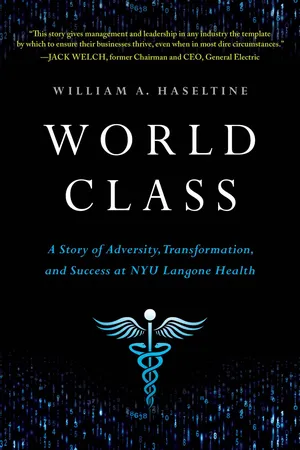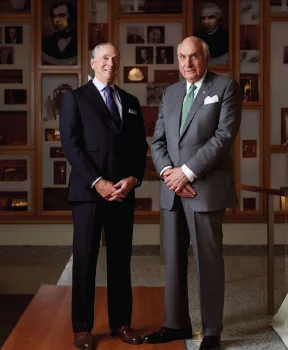![]()
PART I
Vision and Strategy
![]()
CHAPTER 1
From Adversity to Hope
This is a story of how in a few short years the NYU Medical Center, recently renamed NYU Langone Health, went from a low-ranked medical school to the number three medical school in the country, just behind Harvard and Johns Hopkins; from a stagnant research enterprise to a research powerhouse; and from losing money to producing substantial, sustainable operating surpluses. The NYU Langone trifecta—excellence in patient care, teaching, and research—is one of the great turnaround stories in business, let alone medicine. New additions to the NYU Langone portfolio in this story show that the NYU Langone transformation from loss to profit and from low to high quality can be replicated for very different kinds of hospitals, whether they be a safety net hospital serving low income households or a suburban hospital situated amid affluence.
The NYU Langone story is all the more remarkable, as the transformation occurred between 2007 and 2017, a tumultuous period in healthcare in the United States. These years were the setting for a prolonged debate over the Affordable Care Act, rapid changes in payment for medical services, and a revolution in health technologies. The transformation at NYU Langone occurred in the most highly regulated medical environment in the United States and possibly the world, namely New York City. To top off the years of tumult and change, Hurricane Sandy destroyed much of the infrastructure, resulting in a forced closure of the hospital and medical school, delaying most of the research, while inflicting more than a billion dollars’ worth of damage.
Core to the transformation is the leadership of Bob Grossman. His understanding of medicine, biomedical research, information technology, and the business of academic medicine have been the defining elements of success. To many who work with him he is a “pathological optimist.” Key to the transformation is also the close working partnership between Bob Grossman as CEO and Ken Langone, chair of the board of trustees of NYU Langone Health. The support of then–New York University president John Sexton and NYU board chair Martin Lipton set the stage and cleared the way for the changes to follow; then they wisely left Grossman almost alone to work his magic.
NYU Langone Health CEO and dean Robert I. Grossman (left) and chair Kenneth G. Langone (right) in 2017
ADVERSITY
The stories of most transformations, those that succeed and those that fail, in business and academia, begin with adversity. The story of NYU Langone Health is no exception. What was then called the NYU Medical Center slid from excellence in the 1960s and ’70s to near disaster by the end of the century. The financial situation was so dire that many thought the Medical Center would bankrupt the entire university unless they took drastic action. Something clearly had to be done and fortunately was. In this chapter we outline the proud history of the NYU Medical Center, its decline, and the first steps toward transformation and rebirth.
The stories of most transformations, those that succeed and those that fail, in business and academia, begin with adversity. The story of NYU Langone Health is no exception.
HISTORY
The institutions that would become NYU Langone Health were the New York University School of Medicine, founded in 1841, and New York University Hospital, founded in 1960. Throughout most of their history, both the NYU School of Medicine and the NYU Hospital, later named after the Tisch Family and known as Tisch Hospital, enjoyed excellent reputations. The hospital was known for high-quality care and for outstanding work in cardiology, cardiac surgery, and neurosurgery. It was there that Dr. Frank C. Spencer developed new open-heart surgical techniques. The medical school nurtured great physician scientists who made groundbreaking discoveries that led to the eradication of polio and effective treatments for serious mental disorders.
In the 1970s the hospital and medical school were among the top ten in the nation in research funding. By the 1990s they were falling behind. Medicine was changing rapidly, but the NYU Medical Center was not. By 2007, the hospital was in the bottom third in academic medical school rankings for quality and safety and had dropped to 34th in the country in medical school rankings. It ranked 39th in receipt of funds from the National Institutes of Health.
Richard Woodrow, formerly the executive director of the Organizational Development and Learning Department at NYU Langone Health, told me that the NYU Medical Center as a whole “was a complacent, isolated institution, content to rest on past accomplishments.” By the 1990s it had become
“a lovely place to work. People were genuinely nice, civil, content, and disconnected from harsh realities. If you did not want to work hard, you could find a way to appear busy. There was little concern for the external-funding environment. Very few, if any, internal measures for accountability existed, except the budget, which was always in decline. The prevailing belief was that they could ignore the external realities, because the consulting doctors who were part of their network would always refer their private patients to the hospital. There was a belief that great scientists would always be attracted to the historical reputation of the NYU School of Medicine and that excellent students would continue to apply because of its reputation. This was a cordial and polite culture, which valued treating people with kindness, competence, collegiality, and compassion. Yet, this was unwittingly an individualistic, self-congratulatory, inward-looking, top-down, elitist, risk-averse, conflict-averse model of care.”
EXTERNAL CHANGES
As so often happens in any enterprise, external changes precipitated the crisis. The economic structure of medicine was changing. The hospital had traditionally relied on reimbursements for specific services from private paying patients and individual insurance. By the late 1990s the university board believed that the number of private payers would decline sharply and that hospitals would be reimbursed by insurance companies not for individual services they performed but for the number of people they cared for. This was the era of managed care.
The steps to recovery began with the board of trustees of the university. They recognized that the business model of the Medical Center was no longer sustainable. In my interview with William Constantine, a trustee, he noted, “Every aspect of funding a medical center was bleak. There was no money to do anything. You cannot magically bring a fiftyyear-old hospital building up to code. It was hard to recruit anyone.”
From left to right: Martin Lipton, John Sexton, Kenneth G. Langone, and Dr. Robert Berne in 2012 at the Dean’s Honor’s Day
Cost recovery was inefficient and bookkeeping was below par for an institution of its size. Bob Berne, former executive vice president for Health at NYU and the person who first introduced me to the changes that had occurred at NYU Langone, told me, “If healthcare reimbursement was going to be capitated, then healthcare providers would be responsible for covered lives, and we would move away from payment for diagnostic-related groups and cost-based procedures. Our trustees believed we were not prepared for such a shift.”
The trustees also knew that NYU was about to lose one of its major sources of income, royalties from the drug Remicade, which compensated for the losses that were piling up at the Medical Center. The research that led to the development of Remicade was conducted by a professor at the NYU School of Medicine. When the patent expired, so too would the substantial royalty-based income. Steven Abramson, senior vice president and vice dean for Education, Faculty, and Academic Affairs at NYU Langone Health, said in our interview, “Our budget deficit was about $150 million a year. Royalties from the sale of Remicade had been covering our deficit, and we knew these would expire soon.”
Saul Farber served as chairman of the NYU Department of Medicine from 1966 to 2000. He was acting dean of the School of Medicine from 1963 to 1966 and again from 1982 to 1987. He then served as dean and provost of the school until 1997. During that time, the school and the hospital were both administrative units of NYU and were together known as the NYU Medical Center. Farber was a great doctor and a mentor to other great doctors. Under his guidance, NYU became known for having a culture of caring and a sense of dedication to patients. While Abramson expressed great admiration for Farber, he said, “Resources declined in the latter period of Saul Farber’s administration. Change became difficult, and most often funds for innovation were not available. As brilliant as he was, the reality of the Medical Center was that the status quo lingered, and leadership in various departments stagnated.”
In our interview on the eve of his retirement as president of NYU, John Sexton recalled, “Saul Farber was a great doctor and a great human being, but dramatic changes were occurring in medicine. New technologies were being introduced. There were significant changes in the economics of medicine.” He added, “When I was named president in May 2001, I began to look at the university from a strategic perspective. It was very clear that the Medical Center was in trouble. It was in such trouble that it had the potential to bring down the entire university, because it was such a huge part of the enterprise.”
Martin Lipton, my friend and former attorney, who was then nearing the end of his long tenure as chair of the board of trustees of New York University, agreed that there was apprehension “for the university as a whole, if we began to have deficits at the Medical Center.” The board of the university had good reason to feel that the losses being experienced by the hospital could threaten the entire university. NYU had suffered a financial crisis in the 1970s. The school was forced to sell its Bronx campus to the City University of New York and to essentially give away its engineering school by merging it with the Polytechnic Institute of Brooklyn. As a result of the board’s concerns, Lipton said, “We began a series of discussions led in large part by Larry Tisch, then chairman of the university board of trustees, and by George Heyman, a trustee of the university. We considered separately incorporating the hospital to shield the rest of the university. We also began to think about whether or not we should merge the hospital with another hospital.”
The board at NYU held a broader vision for the institution than did its chief executives. The board knew change was necessary, and they were prepared to undertake major changes. This was in contrast to the senior staff members, who appeared inclined to keep doing what they were doing.
The board at NYU held a broader vision for the institution than did its c...







